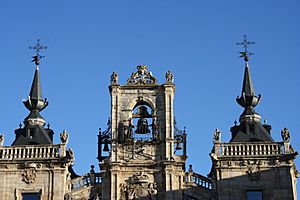Siege of Astorga (1812) facts for kids
The Siege of Astorga in 1812 was an important battle during the Peninsular War. It happened in Astorga, a city in Spain, between June 29 and August 19, 1812. In this battle, Spanish forces fought against French soldiers who were holding the city. The Spanish army won, taking back Astorga.
Quick facts for kids Siege of Astorga (1812) |
|||||||
|---|---|---|---|---|---|---|---|
| Part of the Peninsular War | |||||||
 View of the Town Hall of Astorga |
|||||||
|
|||||||
| Belligerents | |||||||
| Commanders and leaders | |||||||
| Strength | |||||||
| 2,000 14–17 guns |
28,000 | ||||||
| Casualties and losses | |||||||
| 1,200 killed, wounded or captured 14–17 guns lost |
Unknown | ||||||
Contents
What Was the Peninsular War?
The Peninsular War was a big conflict that happened in Spain and Portugal. It was part of the larger Napoleonic Wars. France, led by Emperor Napoleon, fought against Spain, Portugal, and Great Britain. The war lasted from 1807 to 1814.
Why Astorga Was Important
Astorga was a key city because of its location. It was a strong point that the French army controlled. Taking it back was important for the Spanish and their allies. This siege was part of a plan to push the French out of Spain.
The Siege Begins
The siege of Astorga started on June 29, 1812. Spanish troops, led by Lieutenant-General Francisco Gómez de Terán y Negrete, Marquess of Portago, began to surround the city. Their goal was to cut off supplies and force the French soldiers inside to give up.
The Spanish VI Army, under General José María Santocildes, was in charge. They followed orders from General Francisco Castaños. The Spanish army was much larger than the French force defending Astorga.
The Battle and Spanish Victory
The French soldiers inside Astorga fought hard. They tried to hold their ground against the Spanish attack. However, the Spanish army kept up the pressure.
During the siege, some Spanish troops left Astorga. They went to join the main Allied army near Salamanca. This army was led by Arthur Wellesley. These Spanish soldiers helped in other important battles. They captured Tordesillas and blocked French forces in Toro and Zamora. They also took control of Valladolid.
Finally, after a long fight, the French soldiers in Astorga surrendered. This happened on August 18, 1812. The Spanish army had won a big victory.
What Happened Next
The victory at Astorga was a good start for the Allied forces. It was part of a larger plan to push back the French. After Astorga, the fighting continued. The French tried to fight back in other areas, like the Siege of Burgos.
See Also

